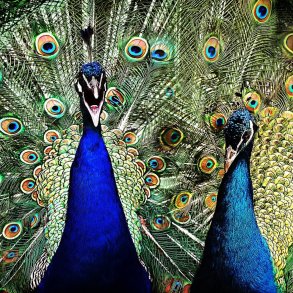By Bettina Hartmann and originally published at spaceholder.dk
Next-stage leadership is (also) Quadrant Leadership? As a person who has both read and loved Frederic Laloux’s book, Reinventing Organizations, and also taken a shine to AQAL (Integral theory), I sometimes lack a structured approach to leadership in the teal movement… It’s natural that we pick out the things we understand and are attracted to! But it also has the danger of creating a lot of shadows? For me, the strength of a teal organization is its ability to make things conscious and to include as many talents and competencies, etc., as possible – without allowing the conflicts and shadows to grow and prevent organic and wholesome progress. We act from trust without being afraid of the darkness ![]()
That’s why I think that as much as we should practice listening to our intuition and using many (other) intelligences than the cognitive and logic ones… we should ALSO remember to use structure and methodology. In order to remember to include as many perspectives as possible. This is even more important if we are doing solo work, or if we do not really know the types and profiles of our colleagues. Maybe they are very similar to ourselves and do not truly help us get a 360 degree perspective? To me, this is where AQAL and integral theory really can offer us something. Because once we have used our intuition, gut feeling and experience, and we see a way forward, we can use AQAL as a check list. You can see an example on this web site, where I have used the five elements of AQAL to describe which qualities and competencies a spaceholder probably should develop in herself.
During a busy day, it’s maybe a bit much to include all five aspects of AQAL as a check list for any or just some of your decisions? Here, I think it’s a good idea to at least use the quadrants. And then use all of AQAL on very big decisions – or just once in a while in a self-check, to see if your preferences are leaning towards the same things, favoring some areas, and excluding others (which is the case for most of us).
This leads me to “quadrant leadership”. Which is basically to remember including both interior and exterior as well as individual and collective perspectives when leading. It’s leading inside out, as well as outside in, at the same time…
Please note, that the above visual is just a rudimentary example of content in each quadrant. It’s a “pointing-out instruction”, trying to give you a feel of what perspective each quadrant holds. So each quadrant could in principle contain an indefinite amount of content, but that wouldn’t really be helpful, would it… So the above (and below) is my discriminatory selection of what I find important. With all my biases, shadows and preferences ?
To make it better, we should come together in a group of people with many different types, intelligences, development levels, states of consciousness, as well as concrete competencies and experiences within leadership… And then see how it could evolve from there! If you feel called to do this work, then contact me, so we can see if we feel called to gather a group and make it happen ?
Upper Left Quadrant – Interior Individual perspective on Leadership:
This is the inner experience of any one individual. Which is not immediately observable to the outside world. People can ask me about my experience and I can try to explain and verbalise. But in the end, only I can hear, see, feel, taste, smell and experience through my ears, eyes, skin and other faculties, and through my particular set of perceptions and beliefs. So even though we share a lot of cultural beliefs etc., it is safe to say that any one individual has a unique experience that is his or her own. And which is hidden from the outside world, including (at least partially) from the individual herself.
We can make it more conscious and share it more with the outside world by different practices. Some of us might also be naturally better at feeling, knowing and understanding what we experience – and to put it into words so that others might get a glimpse as well.
Integral theory suggests that all of the five AQAL elements exists in each quadrant. It would then follow that:
- Lines: I possess a wide array of intelligences, developed to more or less maturity. I am more or less aware of these intelligences, and develop them consciously or not.
- Levels: I will make decisions based on certain values – and maybe my values shifts in different situations, so that I make decisions in one way at work, and another at home. (And I am more or less conscious of this).
- States: I will have access to different states of consciousness, so if I do not meditate or otherwise explore states of consciousness, I will at least have access to ordinary gross consciousness when I am awake, and a more subtle consciousness when I dream at night. (And I am more or less conscious of this).
- Types: I will most likely have certain preferences and dispositions in many different areas, which govern which types I have access to. So I might be the introvert or extrovert type, the intuitive or sensing type, etc. (And I am more or less conscious of this).
- Quadrants: And I will most likely also have preferences when it comes to which quadrants I first tend to use when judging, analyzing, etc.. If I am an extrovert and social type, I might first think about what the we-space (lower left quadrant) would have to say in the matter. If I am an introvert and reflective type, I might first think about how the systems quadrant can help me solve a problem (the lower right quadrant). Etc. (And I am more or less conscious of this).
Integral Life Practice suggests that we have a daily or at least regular practice, to become more conscious, to be able to take more perspectives and to develop the areas that block us from living our potential. The essential practice areas are Body, Mind, Spirit and Shadow. Plus Ethics, Work, Relationships, Creativity and Soul… at least… This means, that a practice layer is added on top of the five elements of AQAL: We use AQAL to find out where our main blocks are, and then create a doable life practice that works for us (and which we get done!), so that we keep expanding and are able to “include & transcend” all healthy aspects of life.
You now see how expansive this work can become! And of course, we need to start where we are, and take it one step at a time. So if I should summarize it, I would write as I did above in the visual: The interior individual perspective is where I understand myself, i.e. my own qualities, values, dispositions and preferences. Where I practice to broaden my view points and be able to take ”all” (many) perspectives by reflecting etc. And where I do regular shadow work, so I know and accept my personal biases and take responsibility for dealing with them. (Etc…).
Upper Right Quadrant – Exterior Individual perspective on Leadership:
This is the observable conditions and behaviours in the individual. It is both the way I walk and talk and look like, but also what my blood pressure is, how fast my heart is beating and the patterns of my brain waves. It could also be my body type and how I respond physically to stress and other situations.
If I should summarize it, I would write it as I did above in the visual: The exterior individual perspective is where I practice my visible leadership behaviours so that people sense that I have integrity, I am the same inside out. I don’t need to be ”perfect”, I just need to be permeable and transparent. And publicly acknowledge my qualities and deficiencies, when relevant to the context. People can role model me in the areas where I have most integrity, and be aware not to role model me where I do not ? (Etc…).
Lower Left Quadrant – Interior Collective perspective on Leadership:
This is where we as a family, a group, an organization, a nation, a people, etc., share certain spoken and unspoken values, languages, cultures, etc. Most of it is hidden and unconscious to us. We sometimes realize it when we are together with people who are very different from us, maybe from a country on the other side of the globe, or from a very different social or work context, or even when we meet our family in law for the first time!
But otherwise, we are in fact mostly unconscious slaves to our cultures, both in our countries and in our families and in our workplaces. Our biological fear of rejection, the fear of being turned away from the safety of the tribe, makes us incorporate a lot of unconscious patterns from childhood and onwards, so that we mostly work on auto-pilot. Which makes us extremely efficient, so it’s really been a good thing for humanity! But if we want to overcome the problems we have in our cultures and the way we work together and the problems we have created on a global level, we probably need to be a lot more conscious about these unspoken and unseen patterns.
Particularly in “wanna-be” teal organizations, this is probably true. Because we are creating the new emerging patterns as we speak, some of it might not even be invented yet, so we need to be even more aware of our unconscious patterns and where they block us. This is both true as individuals (the upper left quadrant) and in teams and groups (the lower left quadrant).
So if I should summarize it, I would write it much as I did above in the visual: The interior collective perspective is where we in our group each take responsibility for our relations and our joint ”we-space”. Where we have conscious practices to make our culture and communication transparent and authentic, to minimize barriers for progress towards true and whole purpose. And where we can deal with shadows and conflicts while they are small, before they do real damage. (Etc…).
Lower Right Quadrant – Exterior Collective perspective on Leadership:
This is the observable part of our collective dealings, which is our infrastructures (physical, technological, etc.), the systems we make use of (political, organizational, monetary, etc.), and so on. Which with leadership eyes translates into the regulations we have to observe (eg. national and global law), the structural framework we have chosen for our organization (traditional hierarchy, Holacracy, self-made, etc.), the infrastructure we have chosen for our dealings or have to follow (such as the internet, social media, certain technologies, physical logistics, monetary exchange systems, etc.). In reality, a lot is given, but we take it for granted and do not question it. Which is maybe wise, as one organization cannot change the whole world, we need to operate within a given framework.
So if I should summarize it, I would write it much as I did above in the visual: The exterior collective perspective is where we structure our collective dealings in ”organizations” and use ”infrastructure” to support our purpose, our values, our current practices. And where we have structures in place to conduct meta or governance improvements of the existing structure. A structure that stays the same for long most likely doesn’t support an organic and living organization. (Etc…).
Co-creation or “tetra-creation” between the four quadrants:
All four quadrants needs to co-create or ”tetra-create”, so that they support each other, are interwoven.
If they exist as separate silos, they do not support agency and communion based on wholeness.
So if you and your “leading men and women” in your organization are lacking practices in just one quadrant, or if the practices in each quadrant do not support each other and correlate with each other – then you most likely will run into problems eventually? Or maybe your tribe will do fine, but the world around you will suffer?
Republished with permission of the author.
Featured Image/graphic link added by Enlivening Edge Magazine.





